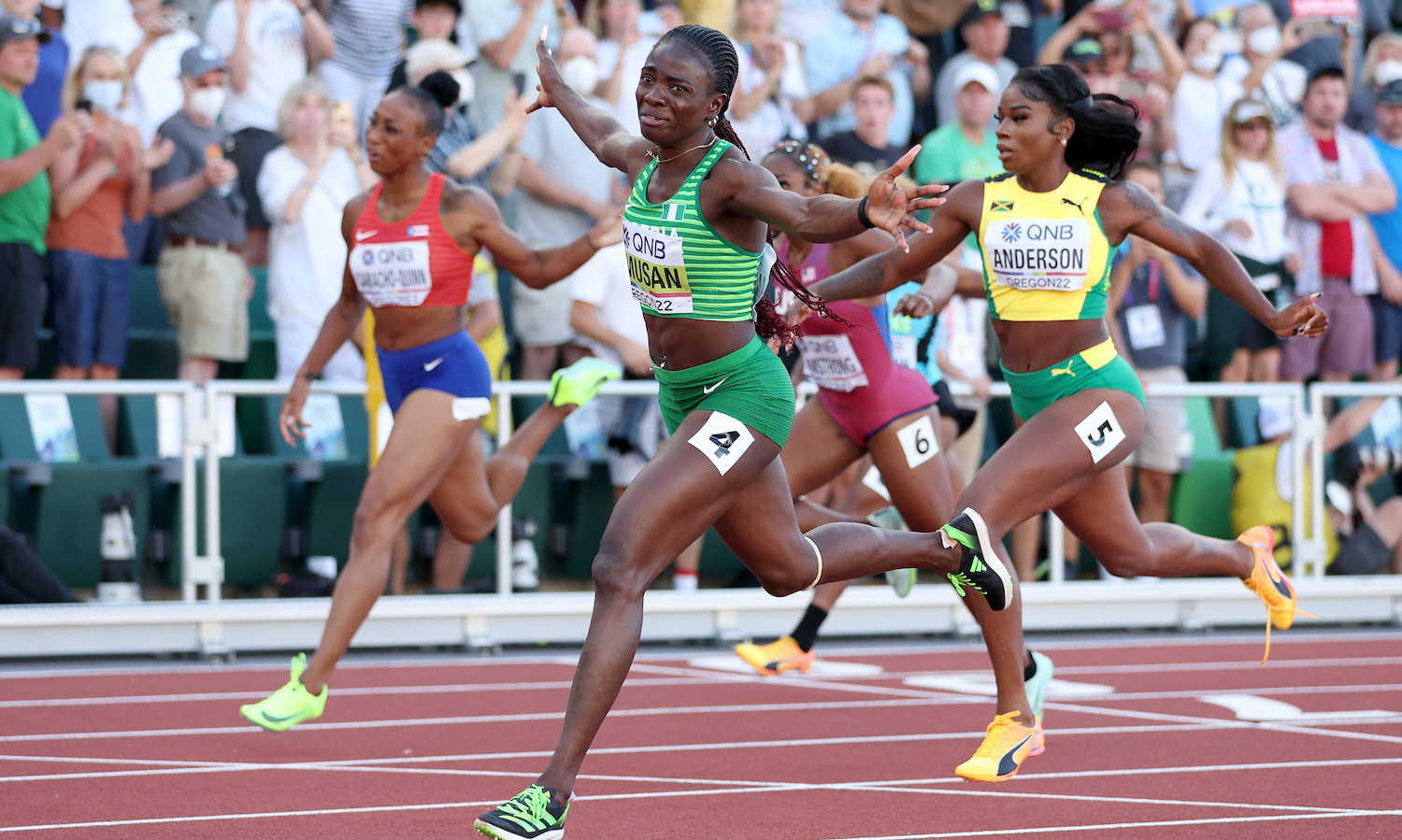A Maddening Attempt To Figure Out Why So Many Runners Broke Records In One Event At The Track World Championships
2:46 PM EDT on July 26, 2022

On the final day of the 2022 track and field World Athletics Championships, hurdler Tobi Amusan snatched Nigeria's first-ever World's gold medal with a pair of stunning runs. Amusan booked her place in the 100-meter hurdles finals with a world record-setting time of 12.12 seconds, then confirmed her status as the world's best by ripping off a 12.06 seconds less than two hours later. Her second time was wind-aided, so she did not officially have the chance to set her second world record of the afternoon. Still, winning her country's first World Championships gold after finishing fourth at both the 2021 Olympics and the 2019 Worlds while lowering the previous world record by 0.08 seconds is a tremendous outcome. The women's 100-meter hurdles field is a superbly competitive one, and Amusan asserted her dominance in unquestionable fashion.
A champion hurdler in full flight is an uncanny sight to behold; Amusan is as controlled as anyone. Her torso and head appear to move smoothly along a uniform horizontal plane, immune from the rhythmic churn of her lower body, like a rubber ducky gliding along the surface of a bathtub full of piranhas.
Breaks world record (12.12) in the semis ✔️
— World Athletics (@WorldAthletics) July 25, 2022
Storms to world 100m hurdles title in the final ✔️
Tobi Amusan 🇳🇬 is on another planet 🪐#WorldAthleticsChamps pic.twitter.com/3hf37HAvEp
But Amusan wasn't unique within the rest of said field in putting forth a record-breaking performance in the semifinals. Of the 22 non-Amusan semifinalists to post an official finishing time, four set new national records, 12 runners (including the new national record-setters) ran their fastest-ever times, and 17 (including the new personal best-setters) ran the fastest races of their seasons. Amusan's new world record was 0.28 seconds faster than her previous personal best, which is an astonishing improvement in a race as short as the 100-meter hurdles. Even she appeared stunned to learn that she had just run the fastest race in recorded history. The last four times the world record has fallen, new record-setters have lowered the bar by 0.01, 0.04, 0.01, and 0.03 seconds. It is not inconceivable that Amusan could have broken the record by such a significant amount of time; after all, her winning margins in both the semifinal and final were roughly the same, and she is clearly the world's best 100-meter hurdler. But the record low times across the board are odd, and even though Michael Johnson caught a ton of shit from Nigerian fans for raising his eyebrow at the new world record, it's completely fair to do so.
I don’t believe 100h times are correct. World record broken by .08! 12 PBs set. 5 National records set. And Cindy Sember quote after her PB/NR “I throughly I was running slow!” All athletes looked shocked.
— Michael Johnson (@MJGold) July 25, 2022
There are a number of possible explanations for anomalously fast times in a trio of heats. The first one proffered for Amusan's success can be dismissed out of hand. Though Amusan's footwear generated plenty of headlines, her choice to wear Adidas spikes meant for distance runners isn't relevant whatsoever. Amusan told reporters she'd been dealing with patella fasciitis all season, and when she asked Adidas for a spike with a softer sole, they recommended a set of lighter distance spikes. A weight differential matters more in hurdles than a two-dimensional sprint, as runners must hoist their legs up over 10 barriers over the course of 100 meters. A shoe that's a few grams lighter thus converts to a more meaningful weight savings for a 100-meter hurdler than for a 100-meter sprinter. Not that it matters in this case. Amusan wore legal spikes, and she smoked everyone. The question is not why she set a new record by such a big margin, it's why the entire field also set records of their own.
This raises the question of the timing system used at Hayward Field. When the margins are this fine, a difference of a few hundredths of a second make all the difference, so any wobble matters. But again, it's not like USA Track & Field is taking these times by hand, they have a contract with a company called Lynx for a dully automatic timing system. Lynx's marketing materials boast of cameras that capture 20,000 frames per second, capable of accurate results to the ten-thousandth of a second. They measure reactions times, communicating with sensors on the starting blocks, and have several redundant cameras to ensure they can still triangulate the correct result in the event of some technical error. The specs are incredibly detailed. [Correction, 4:17 p.m. ET: The event was timed using Seiko technology, which functions in the same way.]
The crux of the issue here is reaction time. IAAF regulations actually have a maximum reaction time, and any athlete that moves off the starting blocks in less than 100 milliseconds is given a false start. This is a pretty punitive rule, as it punishes athletes for reacting too well. Eagles wide receiver and 100-meter hurdler Devon Allen was disqualified from the men's final because his reaction time was 0.099 seconds, one-thousandth of a second too fast. Studies have shown that humans are capable of reacting within 80 milliseconds, which makes the 100 millisecond barrier a somewhat arbitrary and cruel line of demarcation. It's not like Allen jumped the gun, he simply moved faster than anyone else. Amusan herself has elite reflexes and has been punished before for being thousandths of a second too fast. I am not physiologically capable of beating the Lynx timing system, so while it's possible there was an issue with the starting block sensors, it seems pretty incontrovertible that Amusan made her way from the starting blocks, over the 10 barriers, and to the finish line 100 meters away in 12.12 seconds.
The only culprit left is the wind. The track at Eugene's Hayward Field is known to produce fast times, some wind-aided, some legal. The company that manufactures the surface of the track chalks this up to their own superior work, which might be true, though for our purposes, is an incomplete explanation. After all, the men's hurdlers produced a crop of times roughly in line with expectations, a handful of runners setting personal and season bests. USATF regulations require officials to use a wind gauge for all horizontal jumping events and short sprints, defined as 200 meters and lower. This makes some sense: A windy 400-meter race would necessarily expose athletes to both headwinds and tailwinds. The wind gauge sits at the 50-meter line, 1.2 meters off the ground. When the starting gun fires, the wind gauge automatically measure the wind for a 10-second period and reports its finding immediately. Anything over two meters per second, and the times go down in the record books as wind-aided.
The fateful semifinal where everyone set records did have a tailwind, though it was only 0.924 meters per second. Squarely legal. You can tinker around with wind correction calculators, which shows a near-equivalence between Amusan's semifinal and final performances. According to a calculator made for a 2018 article published in the European Journal of Sport Science, a time of 12.06 with a tailwind of 2.5 m/s equates to a windless 12.23, and 12.12 at 0.9 m/s equates to 12.20. Given that this calculator only goes to the tenths place and that the actual wind-aids were 2.524 and 0.924 respectively, we can assume the calculations are roughly correct and that Amusan's actual athletic performance was better in the semifinal, though only slightly.
One can make a vanishingly minute case for either a wind or time anomaly. And sure, it is theoretically possible that a gust of wind greater than 0.924 meters per second swept along the semifinalists on the track while registering a lower number at the gauge yards away, or that the strong wind blew before or after the gauge's pickup zone. But I don't have the fluid dynamics theory down well enough to figure that out, nor the wind vector field data from the track-level of Hayward Field from 5:05 p.m. PT to 6:05 p.m. PT on Sunday, July 24. It is also within the realm of theoretical possibility that the starting blocks had incorrectly calibrated sensors that lowered every runner's time by, say, one-tenth of a second in the semifinal before quietly being set back to normal before any of the other sprint events. We don't know, and unless there's a conspiracy between USATF officials, we can't know. Though the slew of new record times certainly points towards an irregularity of some kind, the best we can do is outline the contours of the possibility space.
There is only one objective certainty: Tobi Amusan kicked everyone's ass and is a World Champion worth toasting.
If you liked this blog, please share it! Your referrals help Defector reach new readers, and those new readers always get a few free blogs before encountering our paywall.
Staff Writer
Stay in touch
Sign up for our free newsletter




